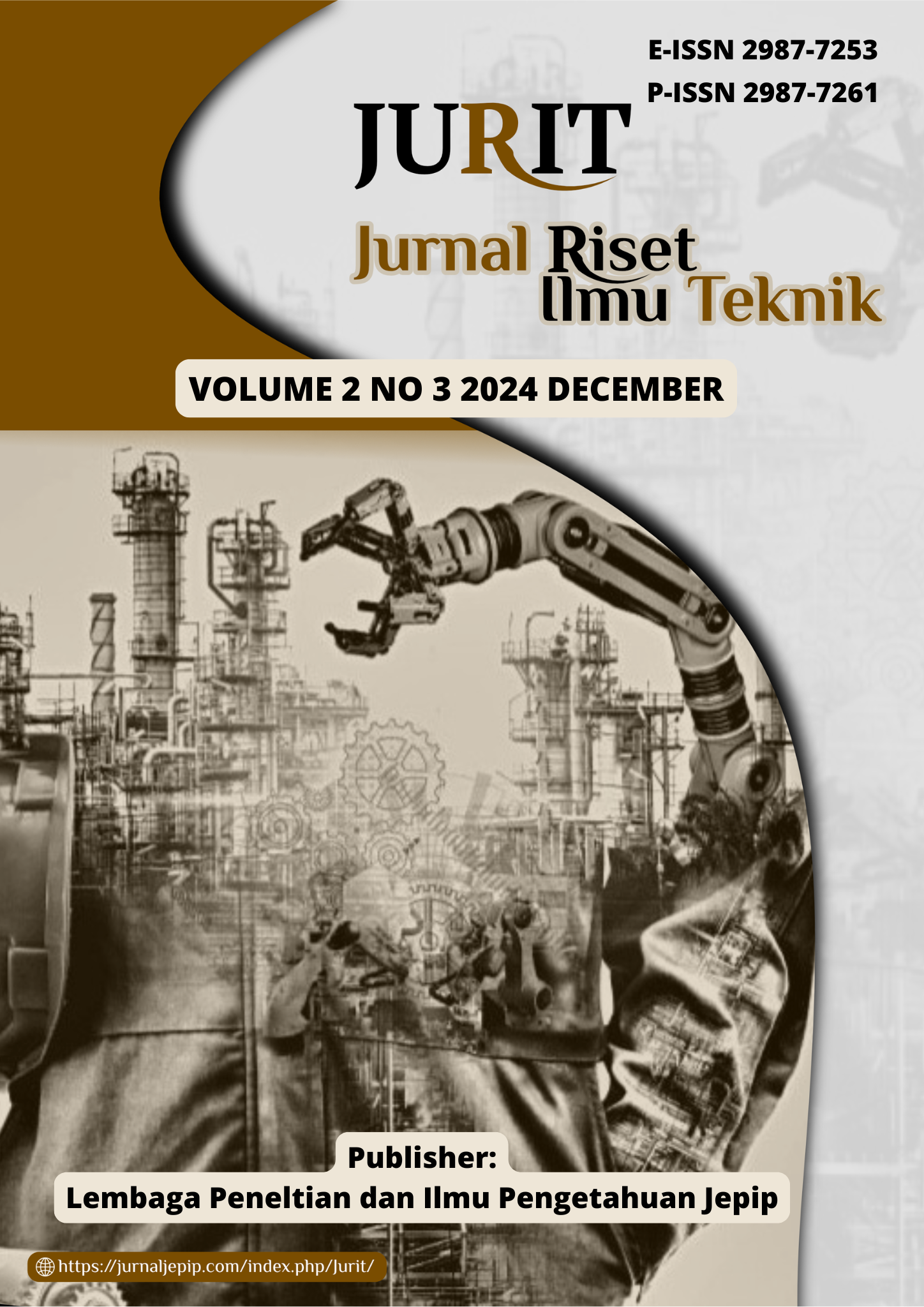Backpropagation Neural Network Model for Predicting Spare Parts Demand Under Dynamic Industrial Conditions
DOI:
https://doi.org/10.59976/jurit.v2i3.124Abstract
Purpose – This study aims to analyze and control spare parts inventory in pumping units at PT. XYZ using the Artificial Neural Network (ANN) method. The research addresses the challenges of surplus and shortage of spare parts, which directly affect operational continuity, production costs, and company performance. Design– A qualitative approach combined with quantitative modeling was employed. Data were collected through observation, the dataset was normalized and divided into three training-testing scenarios (70:30, 80:20, and 90:10). The ANN model with backpropagation was developed and tested using Matlab software, with accuracy evaluated through Mean Squared Error (MSE) and correlation coefficient (R). Findings – The results show that Scenario 2 (80% training and 20% testing data) provides the best balance, yielding the highest accuracy. The ANN model captured nonlinear inventory patterns, achieving very low MSE (3.1358e-12) and demonstrating predictive reliability. However, the overall correlation (R = 0.6015) indicates the need for larger datasets and model refinement to improve generalization. Practical implications – Applying ANN in inventory management helps companies minimize risks of overstock and shortages, reduce storage costs, and support reliable production planning. This contributes to supply chain resilience and enhances customer trust in operational performance. Originality – This study presents one of the first applications of ANN for spare parts inventory prediction in Indonesia’s pumping unit sector. The findings provide empirical evidence of ANN’s effectiveness and offer theoretical as well as practical contributions to the advancement of AI-based inventory management in industrial contexts.
References
G. Dudek, “A Hybrid Residual Dilated LSTM and Exponential Smoothing Model for Midterm Electric Load Forecasting,” IEEE Trans. Neural Networks Learn. Syst., vol. 33, no. 7, pp. 2879–2891, 2022, doi: 10.1109/TNNLS.2020.3046629.
T. Sathish, “Exponential smoothing method against the gradient boosting machine learning algorithm-based model for materials forecasting to minimize inventory,” Aip Adv., vol. 14, no. 6, 2024, doi: 10.1063/5.0208491.
C. Rao, “Energy demand forecasting in China: A support vector regression-compositional data second exponential smoothing model,” Energy, vol. 263, 2023, doi: 10.1016/j.energy.2022.125955.
J. Shi, “A dual attention LSTM lightweight model based on exponential smoothing for remaining useful life prediction,” Reliab. Eng. Syst. Saf., vol. 243, 2024, doi: 10.1016/j.ress.2023.109821.
Y. Xie, “Real-Time Prediction of Docker Container Resource Load Based on a Hybrid Model of ARIMA and Triple Exponential Smoothing,” IEEE Trans. Cloud Comput., vol. 10, no. 2, pp. 1386–1401, 2022, doi: 10.1109/TCC.2020.2989631.
M. B. A. Rabbani, “A Comparison Between Seasonal Autoregressive Integrated Moving Average (SARIMA) and Exponential Smoothing (ES) Based on Time Series Model for Forecasting Road Accidents,” Arab. J. Sci. Eng., vol. 46, no. 11, pp. 11113–11138, 2021, doi: 10.1007/s13369-021-05650-3.
H. M. Zhao, “Measuring the impact of an exogenous factor: An exponential smoothing model of the response of shipping to COVID-19,” Transp. Policy, vol. 118, pp. 91–100, 2022, doi: 10.1016/j.tranpol.2022.01.015.
W. Sulandari, “Exponential Smoothing on Modeling and Forecasting Multiple Seasonal Time Series: An Overview,” 2021. doi: 10.1142/S0219477521300032.
D. Guleryuz, “Forecasting outbreak of COVID-19 in Turkey; Comparison of Box–Jenkins, Brown’s exponential smoothing and long short-term memory models,” Process Saf. Environ. Prot., vol. 149, pp. 927–935, 2021, doi: 10.1016/j.psep.2021.03.032.
G. Yang, “Short-term Load Forecasting Based on Holt-Winters Exponential Smoothing and Temporal Convolutional Network,” Dianli Xitong Zidonghua Autom. Electr. Power Syst., vol. 46, no. 6, pp. 73–82, 2022, doi: 10.7500/AEPS20210409003.
S. Smyl, “ES-dRNN: A Hybrid Exponential Smoothing and Dilated Recurrent Neural Network Model for Short-Term Load Forecasting,” IEEE Trans. Neural Networks Learn. Syst., vol. 35, no. 8, pp. 11346–11358, 2024, doi: 10.1109/TNNLS.2023.3259149.
I. Svetunkov, “Complex exponential smoothing,” Nav. Res. Logist., vol. 69, no. 8, pp. 1108–1123, 2022, doi: 10.1002/nav.22074.
C. Deng, “Equipping seasonal exponential smoothing models with particle swarm optimization algorithm for electricity consumption forecasting,” Energies, vol. 14, no. 13, 2021, doi: 10.3390/en14134036.
T. Alam, “A Comparative Study of CO2Emission Forecasting in the Gulf Countries Using Autoregressive Integrated Moving Average, Artificial Neural Network, and Holt-Winters Exponential Smoothing Models,” Adv. Meteorol., vol. 2021, 2021, doi: 10.1155/2021/8322590.
I. Svetunkov, “A new taxonomy for vector exponential smoothing and its application to seasonal time series,” Eur. J. Oper. Res., vol. 304, no. 3, pp. 964–980, 2023, doi: 10.1016/j.ejor.2022.04.040.
J. L. R. N. Cunha, “A hybrid model based on STL with simple exponential smoothing and ARMA for wind forecast in a Brazilian nuclear power plant site,” Nucl. Eng. Des., vol. 421, 2024, doi: 10.1016/j.nucengdes.2024.113026.
G. Moiseev, “Forecasting oil tanker shipping market in crisis periods: Exponential smoothing model application,” Asian J. Shipp. Logist., vol. 37, no. 3, pp. 239–244, 2021, doi: 10.1016/j.ajsl.2021.06.002.
M. H. P. Swari, “Comparison of Simple Moving Average, Single and Modified Single Exponential Smoothing,” 2021. doi: 10.1109/ITIS53497.2021.9791516.
C. Yu, “Time series analysis and forecasting of the Hand-Foot-Mouth disease morbidity in China using an advanced exponential smoothing state space TBATS model,” Infect. Drug Resist., vol. 14, pp. 2809–2821, 2021, doi: 10.2147/IDR.S304652.
G. Fu, “Look-ahead prediction of spindle thermal errors with on-machine measurement and the cubic exponential smoothing-unscented Kalman filtering-based temperature prediction model of the machine tools,” Meas. J. Int. Meas. Confed., vol. 210, 2023, doi: 10.1016/j.measurement.2023.112536.
S. K. Safi, “A hybrid of artificial fneural network, exponential smoothing, and ARIMA models for COVID-19 time series forecasting,” Model Assist. Stat. Appl., vol. 16, no. 1, pp. 25–35, 2021, doi: 10.3233/MAS-210512.
F. E. Sapnken, “A whale optimization algorithm-based multivariate exponential smoothing grey-holt model for electricity price forecasting,” Expert Syst. Appl., vol. 255, 2024, doi: 10.1016/j.eswa.2024.124663.
U. M. Butt, “Hybrid of deep learning and exponential smoothing for enhancing crime forecasting accuracy,” PLoS One, vol. 17, no. 9, 2022, doi: 10.1371/journal.pone.0274172.
W. Wei, “Time series prediction for the epidemic trends of monkeypox using the ARIMA, exponential smoothing, GM (1, 1) and LSTM deep learning methods,” J. Gen. Virol., vol. 104, no. 4, 2023, doi: 10.1099/jgv.0.001839.
S. Hansun, “Prediction of jakarta city air quality index: Modified double exponential smoothing approaches,” Int. J. Innov. Comput. Inf. Control, vol. 17, no. 4, pp. 1363–1371, 2021, doi: 10.24507/ijicic.17.04.1363.
M. Udenio, “Exponential smoothing forecasts: taming the bullwhip effect when demand is seasonal,” Int. J. Prod. Res., vol. 61, no. 6, pp. 1796–1813, 2023, doi: 10.1080/00207543.2022.2048114.
V. W. Nirmala, “Sales Forecasting by Using Exponential Smoothing Method and Trend Method to Optimize Product Sales in PT. Zamrud Bumi Indonesia During the Covid-19 Pandemic,” Int. J. Eng. Sci. Inf. Technol., vol. 1, no. 4, pp. 59–64, 2021, doi: 10.52088/ijesty.v1i1.169.
L. Kumar, “A comparative assessment of holt winter exponential smoothing and autoregressive integrated moving average for inventory optimization in supply chains,” Supply Chain Anal., vol. 8, 2024, doi: 10.1016/j.sca.2024.100084.
L. Rubio, “Ebitda index prediction using exponential smoothing and arima model,” Mathematics, vol. 9, no. 20, 2021, doi: 10.3390/math9202538.
I. Djakaria, “Covid-19 forecast using Holt-Winters exponential smoothing,” 2021. doi: 10.1088/1742-6596/1882/1/012033.
M. R. Fauzi, “State-of-Health Prediction of Lithium-Ion Batteries Using Exponential Smoothing Transformer With Seasonal and Growth Embedding,” IEEE Access, vol. 12, pp. 14659–14670, 2024, doi: 10.1109/ACCESS.2024.3357736.
M. H. P. Swari, “Optimization of Single Exponential Smoothing using Particle Swarm Optimization and Modified Particle Swarm Optimization in Sales Forecast,” 2022. doi: 10.1109/ITIS57155.2022.10010034.
E. Kahraman, “Comparison of exponential smoothing methods in forecasting global prices of main metals,” Miner. Econ., vol. 36, no. 3, pp. 427–435, 2023, doi: 10.1007/s13563-022-00354-y.
E. Kolemen, “A new deep recurrent hybrid artificial neural network of gated recurrent units and simple seasonal exponential smoothing,” Granul. Comput., vol. 9, no. 1, 2024, doi: 10.1007/s41066-023-00444-4.
Downloads
Published
How to Cite
Issue
Section
License
Copyright (c) 2024 Devi Puspitata Sari, Lei Hou, Zong Woo Geem

This work is licensed under a Creative Commons Attribution 4.0 International License.





















